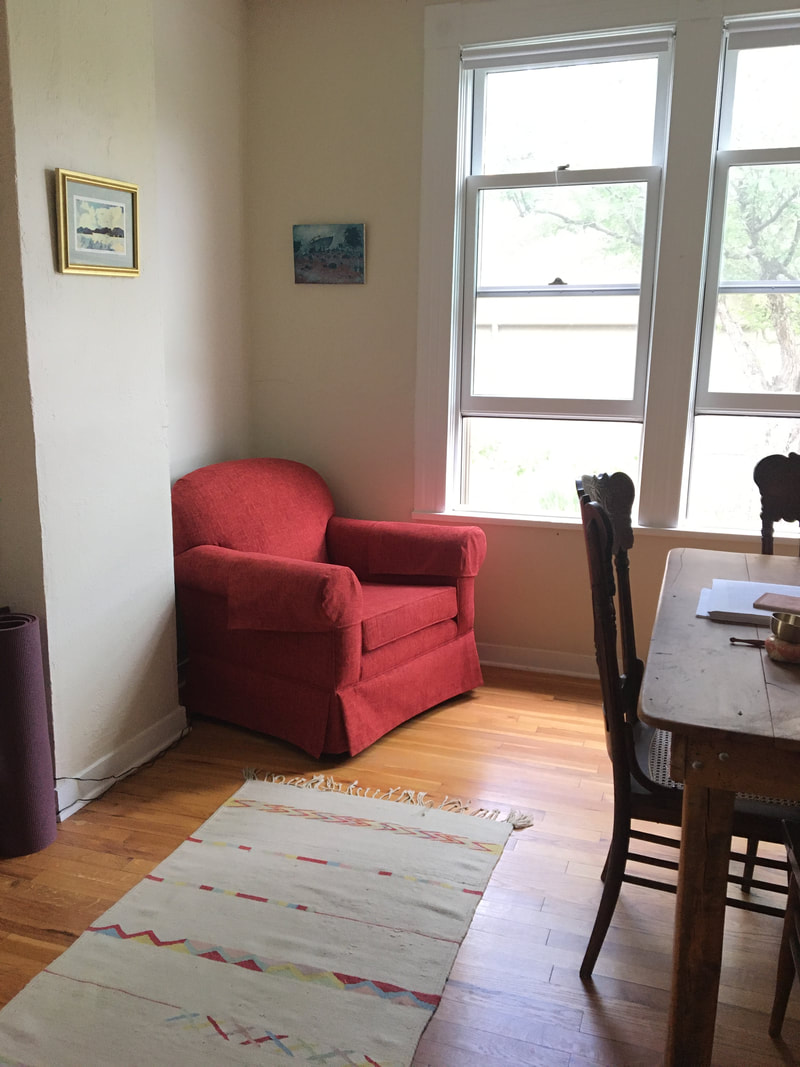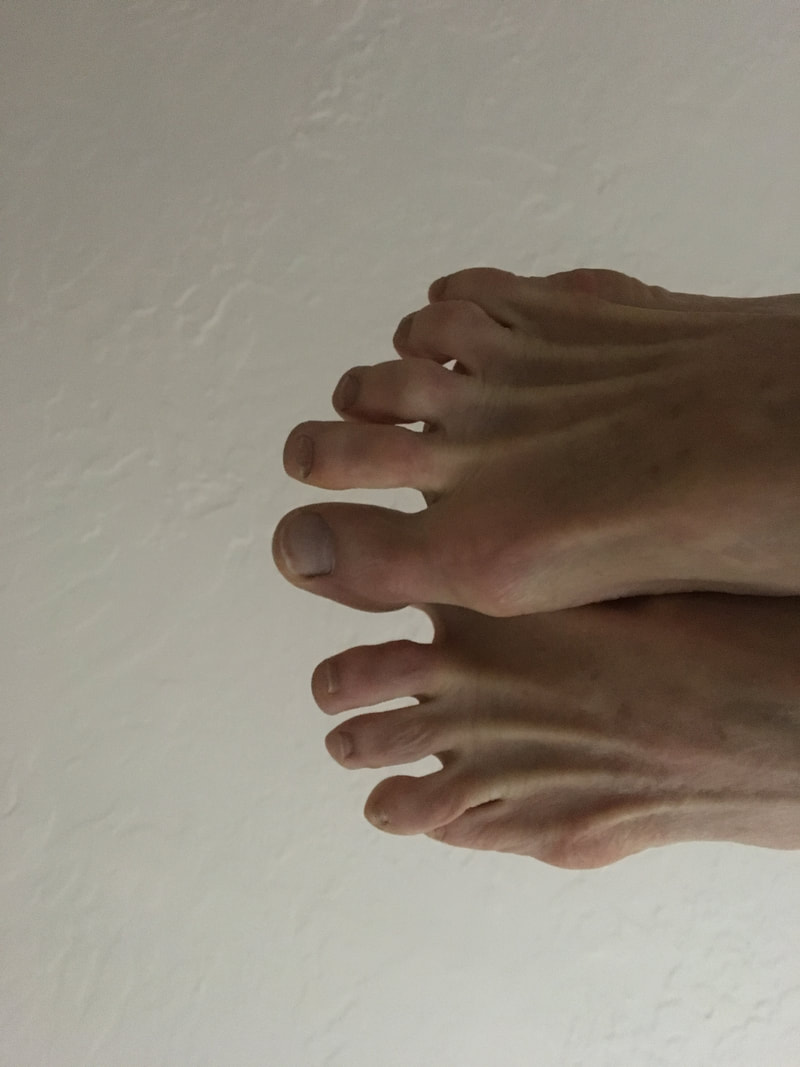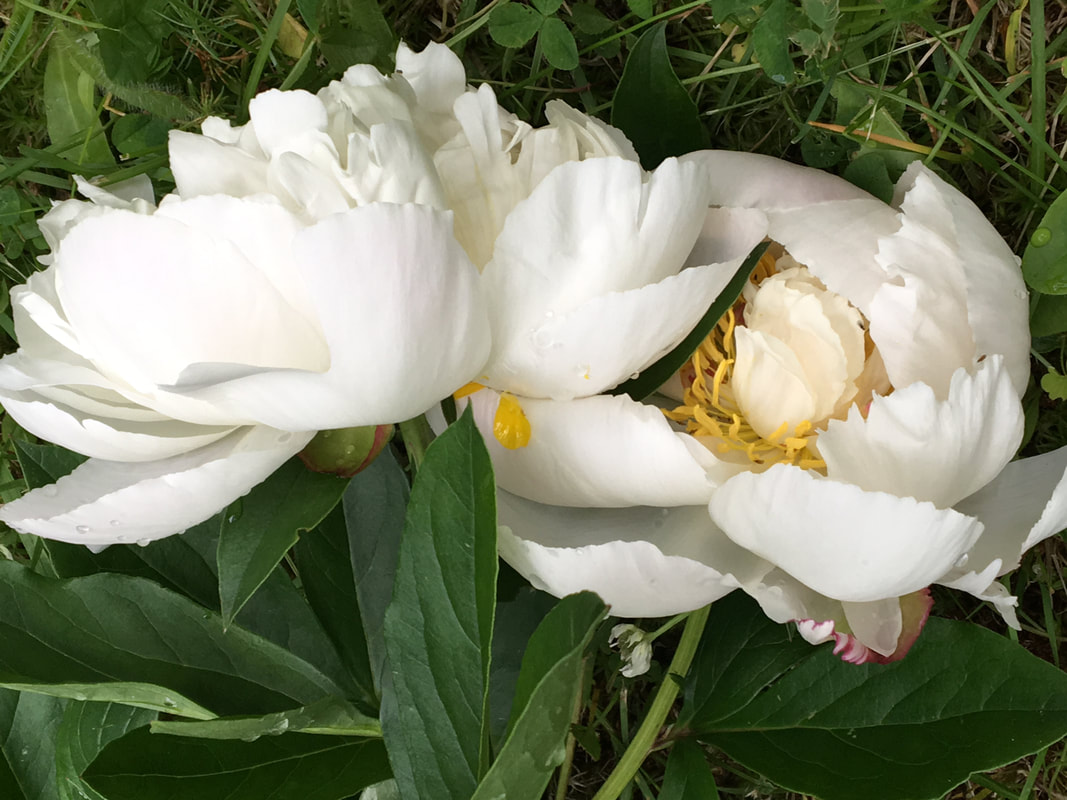|
For years I had a chair I never sat in. “It’s the wrong color,” I said. “Pale blue and yellow. I can’t sit in a pastel chair.” So it sat by itself. Occasionally we piled blankets on it and yoga mats and meditation cushions. It took up quite a bit of space in the living room. It faced a window onto the busy street. For people-watching, it occupied prime real estate, but I didn’t sit in it. Nobody sat in it. “Those pastels,” I said.
I grew up in floral and pastel surroundings. My mother made slipcovers for all our chairs, and for reasons in line with the 1950s, she favored unobtrusive, non-declarative shades of green, blue and yellow. If roses were available against a background of beige, we sat on roses. I was in my late fifties before I understood that walls could be painted rich, deep colors and the house wouldn’t fall apart. We go to what we know, and other people are there to reroute us if we allow them to. I’m going to suggest we’re in a stubborn time in our country right now, simply because we keep going to what we think we know. And it does, to our surprise or satisfaction, keep producing the same outcomes. Until we reject those outcomes, we’ll continue to not sit in the pastel chair. My mother moved out of the ‘50s along with everyone else. I was in college when she started using Marimekko fabric. Marimekko designs had big bold shapes, often in black and white, or a red or bright orange—seldom blue and green, and never yellow. In her own clothes she moved on to natural-colored linens that were quiet without being pastel. As her children left home she began to take risks, to move into unknown territory, and I must say there was a deep beauty about her boldness. Boldness, I saw, didn’t have to be loud, didn’t have to shout; it was a frame of mind that dared to explore a new way of being. We, as American people, lack boldness at this moment. Our trenches have deepened over the last four years and we’re digging in, going with what we’re sure we know, living in a vanishing past. We’re operating out of fear, a great wealth of it, suppressed and gone awry. Change, yes, both noun and verb. Change! When I moved away from the house in which the pastel chair ruled our lives, I astonished myself by taking the chair with me. With one amendment. I took it to the upholsterer and asked my friend, Lynne, to come with me to pick out colors. I wanted rerouting; the whole situation needed rerouting. I exercised boldness and together we chose a magnificent red, a red subtly laced with orange and black, without one trace of blue or yellow in it. This chair—The Red Chair, as I call it—is now the chair I sit in to write. This morning, thinking about America from my perch in The Red Chair, and feeling the last soft days of summer breezing in through the window, and watching the play of light in the apple tree just beyond the window, I felt settled for the first time in half a decade. I felt sorry instead of disbelieving and angry. I felt myself as part of a great unknowing, willing to unknow. It is the boldest move we can make, to give up our investment in a fixed present, a familiar present, whether comfortable or not, and launch into an unknown that does not promise one damn thing except the satisfaction of daring to explore a new way of being. If there’s a chair in the room, please do what needs to be done to sit in it.
2 Comments
Impossibly, one Christmas my mother gave me a raccoon coat. It was not a new coat, but neither was it the worse for wear. The fur, or pelt might be a more accurate word, was not moth-eaten or sorry looking, if a bit dull, and my mother had replaced the entire lining with the same brilliant blue fabric that covered our living room chairs. She had rebuilt the coat from the inside and she presented it to me that Christmas, the Christmas I was twelve, with a beam of pride that broke my heart. Because the last thing in the world I wanted was to walk out into the jungle of New York City and through the doors of my school wearing a bunch of dead animals on my body. The last thing I wanted was a raccoon coat. I thanked my mother profusely, overdoing it to cover my shame. It was the shame of ingratitude, the anticipatory shame of arriving as I must in front of 610 East 83rd Street, my school, and being the laughing stock, the butt of the joke, the blushing target of everyone’s unmerciful teasing. Juanita Dugdale had worn a modest fur hat to school one day and for that she was crucified. I knew the consequences and my mother did not. Her plan was to save me in style from those cold New York winters, but in fact she was throwing me to the wolves.
My older sister’s best friend, Kate, was the first to land a dart. She looked me up and down and smiled dangerously as we stood at the bus stop together. “Height of prep,” was all she said. I remember the sting of it to this day. But I was grateful for the efficiency, the brevity of her blow. Others were not so reserved, or rather not so accurate in the delivery of their poison arrows, and several seemed genuinely confused as to whether or not the coat was made from our own pet raccoon, Mr. Peepers, who had come and gone in our lives several years before. I came home from school and stood as I always did in front of the cracker and potato chip closet above the built-in oven in our kitchen, and cried. I had not even bothered to take off the coat and I stood and hung my head and blubbered into the scratchy fur that came up to meet my face. Here it was, this hideous coat with its beautiful, elegant, blue as the blue sky lining, hand-sewn by my beautiful, elegant mother, and I had to choose. I had to either bear the shame or refuse the gift, which at that moment felt like refusing the gift of life she had also given me. With all its difficulties and uglinesses, I hadn’t refused that gift, had I? the gift of life? It was difficult and complicated, even hideous at times, but I had chosen to concentrate on life’s beautiful blue lining and now, I decided right there in the kitchen, I would do that again. I was going to write about the Richmond statues this week, and the writing and rewriting of history, which is what history is—an ongoing draft of a story from different points of view. But I decided instead to write about flowers. Not because, like my line-toeing ancestors, I don’t want to ruffle feathers. I do, in fact. Healthy feather-ruffling leads to conversation and greater understanding, and what we need more than ever right now is some patient listening and a good exchange of ideas. But I haven’t been in a position to patiently listen to why it makes sense to venerate the heroes of a coalition against which we were at war, many of whom believed in a system of ownership of and forced labor by other human beings. I would like to listen to someone in whose mind that makes sense. I am curious to know how that makes sense. I would like to listen openly rather than shut my own mind to this difference between minds.
Notable: By the time of the Civil War, slavery wasn’t confined to the Confederacy. The Union had slave owners, too. The border states of Maryland, Delaware, Kentucky, Missouri and West Virginia were slave owning, and they continued to be after Abraham Lincoln’s famed Emancipation Proclamation. The president declared the slaves within the Confederate states free, but left slave ownership intact in the useful, resource-rich border states that supplied the Northern army. He did what he thought the war effort demanded, and played his political cards. He went on record as saying, “If I could save the Union without freeing any slave I would do it; and if I could save it by freeing all the slaves I would do it; and if I could save it by freeing some and leaving others alone I would also do that.” Food for thought. Notable: In half of what I’ve read about Robert E. Lee, commander of the Army of Northern Virginia and perhaps the best-known general, North or South, of the American Civil War, he seems like a pretty good guy. By that I mean fair, morally put-together, and capable of great feeling for the young men he ordered into battle. Also, by marriage, a slave owner, and not necessarily a kind one. He married the daughter of George Washington’s adopted son who inherited the Washington family’s slaves (yes, that George Washington), and a year-and-a-half into the Civil War Lee freed them. Notable: They were free and the slaves in the Union’s border states were not. Food for thought. How we respond to the complexity of our fellow human beings, how we accommodate or damn them, is of great interest to me. But I was going to write about flowers. Why flowers? Because they’re beautiful, and when I tear them from the ground and place them in my house, they give me pleasure. Simple. I don’t have to accommodate or damn them. I don’t have to struggle with their complexity. I can just enjoy them, and more and more, as the turning of the world becomes less and less certain, or I should say, as the innate uncertainty of all life becomes more visible to our clouded eyes, or as someone recently said, as people become more and more themselves, we could use a little beauty, a little rest from confusion, conflict, loneliness and doubt. We could use a break from what we know we have to accept. Not right now, please. Five minutes more. Oh, take a look at those flowers! But the last word must go to Robert E. Lee who, it’s said, objected to the idea of raising Confederate monuments. He thought it wiser “not to keep open the sores of war but to follow the examples of those nations who endeavored to obliterate the marks of civil strife.” He would, it seems, advocate the toppling of the statues, including and especially his own. |
AboutA place to discuss writing or anything on your mind. All visitors are invited to join the conversation by commenting on posts, asking questions, and joining the newsletter below for even more opportunities to connect and converse! Archives
April 2023
Categories |




 RSS Feed
RSS Feed